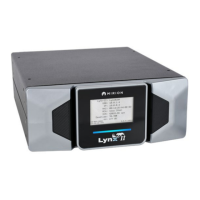Programmable Controls
Lynx II DSA User's Manual – 7096089 143
SLOW DISC MODE
Sets the Slow Discriminator Threshold mode. AUTO: the threshold is optimized
automatically above the system noise level; MANUAL: allows the threshold to be
adjusted manually. Manual mode is useful when working with low energy applications.
Please refer to the Low Energy Applications on page 111 for more details.
SLOW DISC SETTING
Active when SLOW DISC MODE is set to MANUAL; sets the Slow Discriminator
threshold level, range is 0 to 100%. This feature is useful to expose the processing of very
low energy events by setting LLD MODE to MANUAL, Please refer to the Low Energy
Applications on page 111 for more details.
PUR/LTC MODE
ON/OFF; ON: Enables pileup rejector and live time corrector (LTC). LTC generates dead
time to extend the acquisition time to compensate for events that are pile-up and rejected;
OFF: pileup rejector and LTC disabled. Refer to PUR/LTC Operation on page 166 for
more information
LT TRIM
Allows adjustment of the trapezoidal pulse evolution time or dead time to optimize Live
Time Correction (LTC) performance. The adjustment range is 0 to 1000; the default value
of 500 provides good LTC performance for a wide range of applications. Refer to
PUR/LTC Operation on page 166 for more information.
OVERLOAD RECOVERY EXTENSION TIME
Time in microseconds is added to the default overload recovery when a cosmic event
overloads the preamplifier. The default recovery time in the Lynx II is approximately 2.5x
the shaping time (2x RiseTime + Flat Top). The value specified through the Overload
Recovery Extension Time ranges from 0 microseconds to 6,550 microseconds in steps of
10 microseconds.
BLR MODE
AUTO, HARD, MEDIUM, SOFT; AUTO: The baseline restorer is automatically
optimized as a function of trapezoid shaping time and count rate; HARD, MEDIUM, or
SOFT: Sets the baseline restorer to fixed rates as selected.
AUTO POLE ZERO
When activated, the Pole/zero is adjusted automatically for RC PREAMP TYPE by the
device within the range of 40 μs to 1.7 ms; a digital oscilloscope is provided as a user aid
to view the quality of the pole/zero setting while the device is making adjustments. The
oscilloscope reconstructs the tail of the trapezoid signal thus providing visual feedback
that shows the quality of the pole/zero adjustment. The real time reconstructed signal is
also available for viewing with an external oscilloscope at the rear panel's MON OUT
MCX connector.

